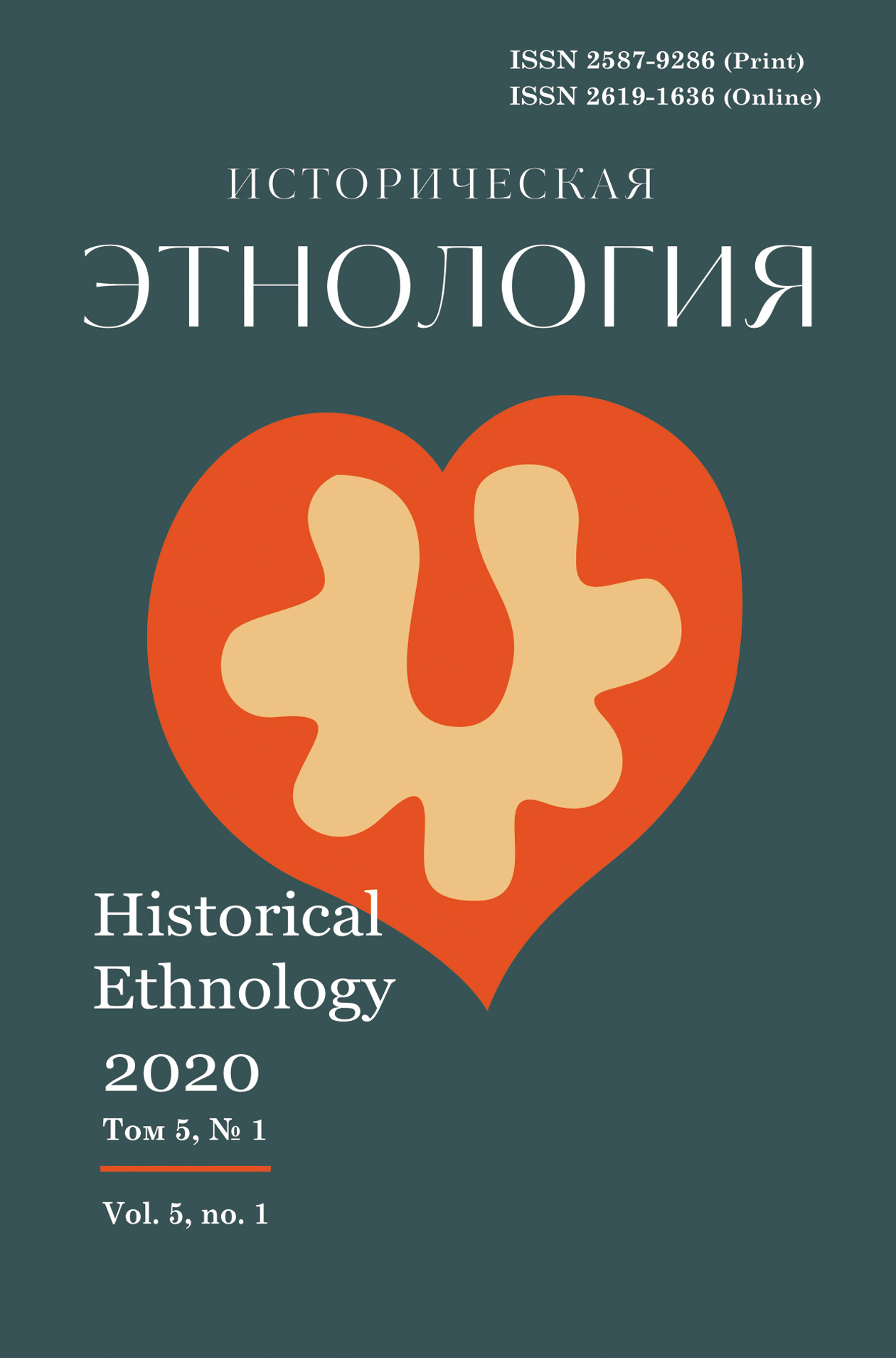Materials for the cultural genesis of the Volga-Ural Tatars: the Nogai component in the structure of folk costume
Suslova S.V.
6-26 p.
doi.org: 10.22378/he.2020-5-1.6-26
The Nogai component in the cultural genesis of the Volga-Ural Tatars is identified by a comparative historical analysis of museum sources and field expedition materials on the folk costumes of the Turkic-Nogai ethnic formations of the Lower Volga region and the North Caucasus. The most important sources were typological and cartographic materials on folk clothing of the Tatars (The Historical and Ethnographic Atlas of the Tatar People) and the Nogais (The Historical and Ethnographic Atlas of the Peoples of Dagestan). The earliest and most noticeable Nogai analogies have been found in costume complexes of the southern group of Mishar Tatars (Temnikovo-Azeyevsky, Lyambirsky, Kuznetsk-Khvalynsky), of Kasimov Tatars, and less often the Kryashen. Through the steppe traditions of the Black Sea and the Caspian Sea regions, they go back to the Turkic, Turkic-Mongolian cultures of Eurasia, in the ethnogenesis and culture of which the Kipchak-Nogai component is obvious. The Nogai analogies are not accidental in the costume of the Siberian, Crimean Tatars of the steppe subgroup, the Bashkirs, Kazakhs, Kirghizes and other Turkic peoples which are connected by the commonality of the Golden Horde and subsequent (Khan’s) period of their history, and continue to maintain close relations, including ethno-cultural links.
Keywords: Tatars, Nogais, cultural genesis, folk clothing, historical and ethnographic Atlas
For citation: Suslova S.V. Materials for the cultural genesis of the Volga-Ural Tatars: the Nogai component in the structure of folk costume. Istoricheskaya etnologiya – Historical Ethnology, 2020, vol. 5, no. 1, pp. 6–26. DOI: 10.22378/he.2020-5-1.6-26
REFERENCES
- Bulatova A.G., Gadzhieva S.Sh., Sergeeva G.A. Odezhda narodov Dagestana. Istoriko-etnograficheskij atlas [Clothing of the peoples of Dagestan. Historical and Ethnographic Atlas]. Pushchino, Russian Academy of Scinces ONTI PNC Publ., 2001. 289 p. (In Russian)
- Gadzhieva S.Sh. Material’naya kul’tura nogajtcev v XIX – nachale XX v. [Material culture of the Nogais in the 19th – early 20th century]. Moscow, Nauka Publ., 1976. 228 p. (In Russian)
- Lobacheva N.P. Osobennosti kostyuma narodov Sredneaziatsko-Kazahstanskogo regiona [Features of the costume of the peoples of the Central Asian-Kazakhstan region]. Sredneaziatskij etnograficheskij sbornik [Central Asian ethnographic collection]. Moscow, Nauka Publ., 2001, pp. 69–97. (In Russian)
- Mikhajlova E.A. S”jomnye ukrasheniya narodov Sibiri [Removable ornaments of the peoples of Siberia]. Ukrasheniya narodov Sibiri [Ornaments of the peoples of Siberia]. St.Petersburg, Museum of Anthropology and Ethnography of the Russian Academy of Sciences Publ., 2005, pp. 12–120. (In Russian)
- Nebol’sin P.I. Inorodtcy Astrahanskoj gubernii. Zametki o kundrovskih tatarah [Foreigners of the Astrakhan Province. Notes on Kondrovsk Tatars]. Vestnik RGO – Bulletin of the Russian Geographical Society, 1851. Part 2. Chapter 5, pp. 1–20. (In Russian)
- Pletnyova S.A. Pechenegi, torki i polovcy v yuzhno-russkih stepyah [The Pechenegs, Torks and Cumans in the southern Rus steppes]. Materialy i issledovaniya po arheologii SSSR [Materials and research on archeology of the USSR]. Issue 62. Moscow-Leningrad, Nauka Publ., 1958, pp. 150–226. (In Russian)
- Pyatnickij V. Karagachi (po materialam poezdki 1927 g.) [Karagash (based on the trip 1927)]. Zemlevedenie, 1930. Vol. 32, Issue III–IV, pp. 155–169. (In Russian)
- Roslavtceva L.I. Odezhda krymskih tatar konca XVIII – nachala XX vv. Istoriko-etnograficheskoe issledovanie [Clothing of the Crimean Tatars of the late 18th – early 20th centuries. Historical-ethnographic research]. Moscow, Nauka Publ., 2000. 149 p. (In Russian)
- Smirnova E.Yu. Tradicionnaya odezhda tobolo-irtyshskikh tatar konca XIX – pervoj treti XX vv. [Traditional clothing of the tobolo-Irtysh Tatars of the late 19th – first third of the 20th century]. Narody Sibiri i sopredel’nyh territorij [Peoples of Siberia and the adjacent areas]. Tomsk, Tomsk University Publ., 1995, pp. 201–219. (In Russian)
- Suslova S.V. Materialy etnograficheskoj ekspedicii v Astrahanskuyu oblast’ 1989 g. [Materials of the ethnographic expedition to the Astrakhan region in 1989]. (In Russian)
- Suslova S.V. Zhenskie ukrasheniya kazanskih tatar serediny XIX – nachala XX vv.: istoriko-etnograficheskoe issledovanie [Women’s jewellery of Kazan Tatars of the mid-19th – early 20th centuries: historical and ethnographic research]. Moscow, Nauka Publ., 1980. 110 p. (In Russian)
- Suslova S.V. O nogajskom komponente v narodnoj odezhde volgo-ural’skih tatar [About the Nogai component in folk clothing of the Volga-Ural Tatars]. Busyginskie chteniya. Vyp.9. Narody v polikul’turnov vzaimodejstvii [Proceedings of Busygin Readings. Issue 9. Peoples in multicultural interaction]. Kazan, 2016, pp. 175–180. (In Russian)
- Suslova S.V., Muhamedova R.G. Narodnyj kostyum tatar Povolzh’ya i Urala (seredina XIX – nachalo XX vv.). Istoriko-etnograficheskij atlas tatarskogo naroda [Folk costume of the Volga and Ural Tatars (mid-19th – early 20th centuries). Historical and Ethnographic Atlas of the Tatar people]. Kazan, Fen Publ., 2000. 311 p. (In Russian)
- Sukhareva O.A. Istoriya sredneaziatskogo kostyuma. Samarkand (2-ya polovina XIX – nachalo XX vv.) [The history of Central Asian costume. Samarkand (2nd half of the 19th – early 20th centuries)]. Moscow, Nauka Publ., 1982. 146 p. (In Russian)
- Tereshchenko A. Sledy Desht-i-Kipchaka i Vnutrennyaya Kirgiz-Kajsacskaya orda [Traces of Desht-I-Kipchak and the inner Kirghiz-Kaysatsk Horde]. Moskvityanin, 1853. Vol. 6, no. 22, pp. 58–74. (In Russian)
- Usmanova E.R., Logvin V.N. Zhenskie nakosnye ukrasheniya Kazahstana (epoha bronzy) [Female hair jewellery of Kazakhstan (bronze age)]. Lisakovsk, 1998. 66 p. (In Russian)
- Faskhutdinova L.F. Tatarskaya vyshivka v kollekcii astrahanskogo muzeya [Tatar embroidery in the collection of the Astrakhan Museum]. Etnologicheskie issledovaniya v Tatarstane [Ethnological research in Tatarstan]. Issue VI. Kazan, 2012, pp. 115–126. (In Russian)
- Fyodorov-Davydov G.A. Kochevniki Vostochnoj Evropy pod vlast’yu zolotoordynskih hanov [Nomads of Eastern Europe under the rule of the Golden Horde khans]. Moscow, Moscow University Publ., 1966. 270 p. (In Russian)
- Sharifullina F.L. Kasimovskie tatary [The Kasimov Tatars]. Kazan, Tatar Book Publ., 1991. 127 p. (In Russian)
- Boyer М. Mongol Jewellery. Nationalmuseets skrifter, Etnografisk Række, V. København, 1952. 224 р. (In Danish)
About the author: Svetlana V. Suslova is a Candidate of Science (History), Leading Research Fellow, Department of Ethnological Research, Sh. Marjani Institute of History of the Tatarstan Academy of Sciences (7A, Baturin St., Kazan 420111, Russian Federation); sv_suslova@mail.ru
|
|








